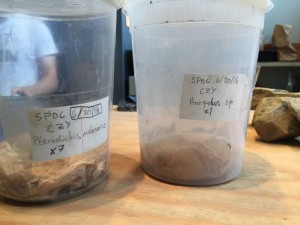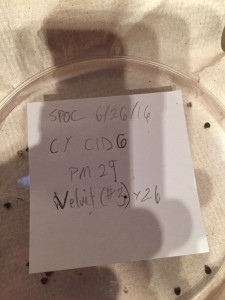In March I was delighted to be hired by Matt Ryan’s Sustainable Cropping Systems Laboratory as a research assistant full time for the summer. Work is made to be so much easier when you’re not only surrounded by very smart and honest people but also have the opportunity to be challenged to understand the complexity of your discipline in greater depth. This happens to be just the experience I’ve had the pleasure of enjoying this summer.
As the summer has progressed I’ve been working more and more with one member of the SCS Lab in particular, the great Connor Youngerman. Connor has three experiments ongoing at the moment. In June my two fellow RAs and I helped begin one of them, S.P.O.C. SPOC is an experiment that was designed earlier this year to test the seed preference of two of the most common local predators in this region of New York State, Harpalus pensylvanicus and Gryllus pensylvanicus.
Seed predation is an interesting subject from the perspective of the SCS lab. Researchers often consider these bugs beneficial because they eat weed seeds that would otherwise compete with agronomic crops for sunlight and water. What those researchers can sometimes overlook, however, is the fact that many of those species that they consider weeds can also be used as cover crops. Cover crops are seeded purposefully and are meant to provide a variety of different ecosystem services for a variety of different reasons. The appeal of cover crops is that their use can provide a way to stimulate ecological health while reducing input (in terms of cost) and maintaining yield consistently over time. By understanding the preference of these insect predators on different plant species within this cover-crop context, one can understand how to direct the use of such covers more efficiently.

For the past couple of months we have been testing 13 different species of weeds and/or cover crops, depending on whom you ask. They include: cereal rye, winter barley, velvet leaf, ragweed, radish, white mustard, crimson clover, red clover, triticale, pearl millet, giant foxtail, hairy vetch, and annual ryegrass.
You can see in these few snapshots some of the protocol upkeep that’s involved with the experiment. About 80 pitfall traps have been ‘installed’ in the field surrounding the Leland Processing Center, where most of the Lab’s experiments are maintained. Every day each trap is inspected and insects of interest are collected and taken back to Leland. Up to this point neither of the species of interest has been found in any significant quantity. We’ve been testing another common seed predator in the area, Pterostichus melanarius. Connor has said that he expects us to begin find more Harpalus in the coming weeks. We usually find anywhere from 15-50 beetles a day. Once beetles are collected they need to be starved for a certain fixed amount of time to control for their desire to eat. They spend four days in the walk-in cooler, in containers like those shown above, along with a wet paper towel as a source of moisture. Once four days passes they are taken out and placed in a petri dish along with 26 seeds of one species of plant and a moist cotton ball. These trials are termed ‘no choice’ because the bug has no choice of what they can eat. For five days at 24-hour intervals after the bugs are placed in their dishes, we record how many seeds each insect has eaten.


